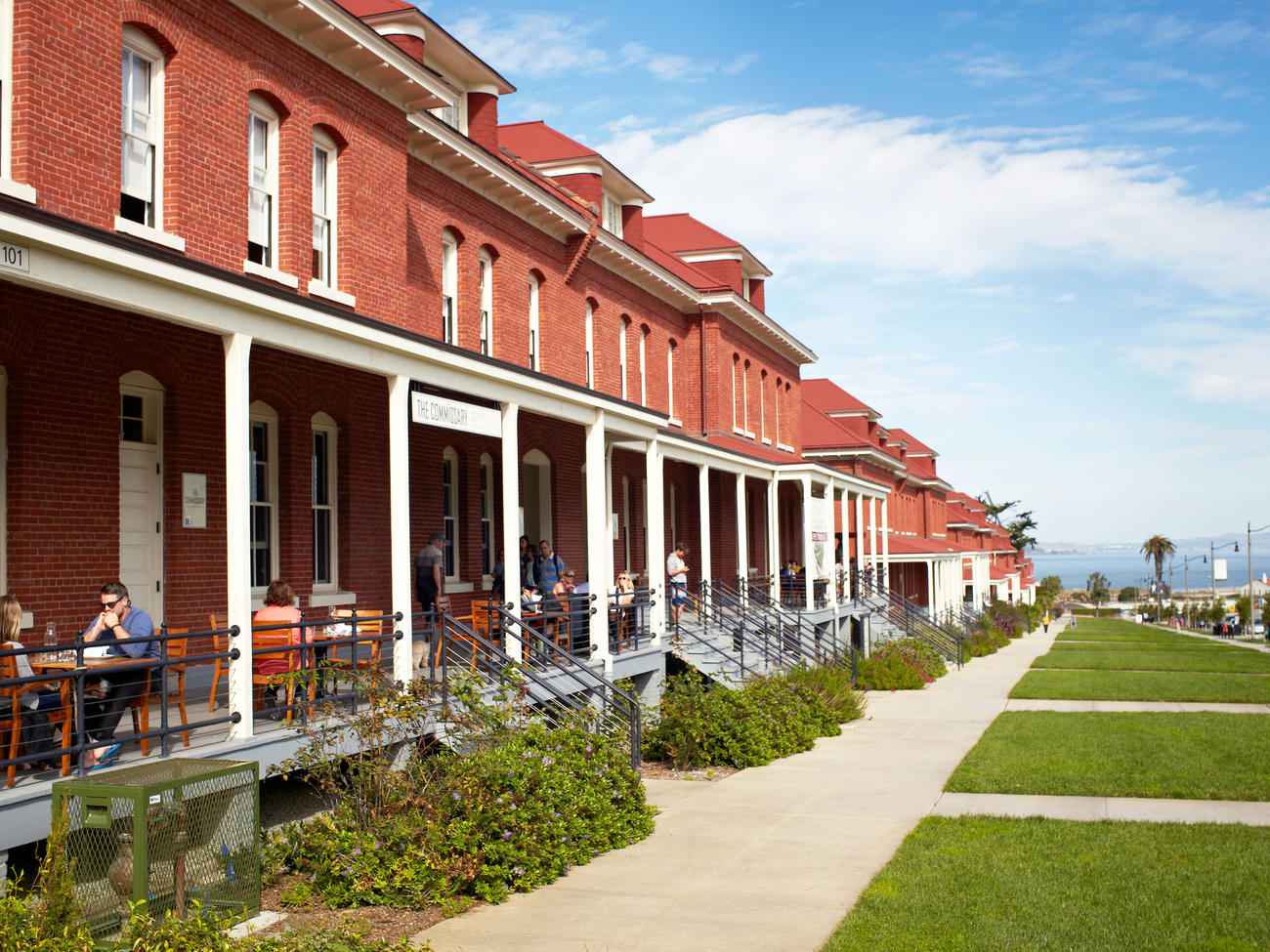
Rolling Forward
Bike, walk, or take a tour of San Francisco’s newly renovated Presidio

David Fenton
Just inside the 15th Avenue Gate of the Presidio of San Francisco, in the lower level of Arion Press, our tour guide has to shout over the noise. A clanging type-making machine spits out newly formed letters and lines them up in orderly rows. Down the hall, bulky letterpresses stand ready to fold these words into sheets; in another room, the pages are sewn into bindings.
.Largely handmade from start to finish, Arion’s extraordinary books include Andrew Jackson Grayson’s Birds of the Pacific Slope, as well as a Seamus Heaney book illustrated by Sol LeWitt. Our guide opens one of Arion’s best-known works, a copy of Moby Dick illustrated with wood engravings by artist Barry Moser. “This is quite a collaboration,” she says.It’s a surprise to find the press―an educational institute, bookmaker, publisher, printer, and typefoundry all rolled into one―in the Presidio, a former military post better known for its bayside views. But with its richly layered history and spectacular location, this army post-turned-national park is full of discoveries, especially right now.The Presidio is an anomaly. The post has been under Spanish, Mexican, and American rule and had a role in every U.S. military conflict of the 20th century. Charged to become financially self-sufficient by 2013, the park is rolling through uncharted territory. With 1,100 residents living in rehabilitated military housing, new businesses such as the huge Sports Basement store, and the much-discussed Lucasfilm digital center under construction, this is a national park like no other. It balances those developments with a mandate to preserve the post’s architectural character, endangered species, and open space, making it an experiment in urban harmony, set in the city’s prettiest corner.And in Arion Press’s light-filled gallery overlooking Mountain Lake Park―where explorer Juan Bautista de Anza and his party camped in 1776 as they established the beginnings of San Francisco―it seems that all of the Presidio is today, in our guide’s words, quite a collaboration.
A Marvel of Nature
On Anza’s expedition, fellow explorer Pedro Font, a priest, called this landscape “a marvel of nature.” Though the place looks decidedly different now, the views remain majestic. Up on the Presidio’s Inspiration Point, tourists and residents take in the blue calm of the bay, dotted with white sailboats. Forested slopes stretch out below, a green carpet so lush you could be fooled into thinking you’re not in the city at all.And you wouldn’t be the only creature fooled. Damien Raffa, a natural-resource specialist for the park, was shocked when residents reported coyote sightings in the park two years ago. He was skeptical until the claim was documented with photographs.It’s one example of the remarkable pairings here. Raffa says he seeks to create “harmonious coexistence” for wildlife and human residents. Residents, for their part, are embracing the opportunity to live with a bit of wildness. “We’re demonstrating that nature does have a place in cities,” Raffa says.What has kept the post undeveloped has largely been the public’s affection. This has also helped transform the landscape in a small but revolutionary way. In the last decade, hundreds of volunteers have worked to restore native plant communities to Crissy Field, Mountain Lake Park, and the bluffs under the Golden Gate Bridge. “It’s the big bonus―to be somewhere beautiful and make it more so,” says five-year volunteer Bernadette C. Hooper.Others come just to appreciate the scenery. On a weekend afternoon, strollers, runners, and dog walkers parade past the sparkling bay on the promenade along Crissy Field. The partially forested Ecology Trail, under the eucalyptus and pine trees planted by the U.S. Army, is a quiet, shady refuge allowing glimpses of wildflowers and the California state rock, serpentine. And a walk along windy Baker Beach offers peaceful views of the Marin Headlands.That’s a lot of variety in this small space. “There’s a texture and complexity in the landscape that is remarkable,” says Michael Boland, associate director for planning at the Presidio Trust, the federal agency established by Congress in 1996 to manage the long-term care of the park. “We have a 300-acre historic forest, a tidal marsh, the last year-round free-flowing stream in San Francisco, a host of historic structures, incredible recreation amenities, endangered species … You could go on and on. It’s incredible.”
Moving Forward, Carefully
Taking care of this diversity is the challenge facing the park. At the Main Post, the former parade grounds at the Presidio’s heart, the sound of hammers and power tools indicates that changes are afoot. But plans involve carefully folding history into the future: The post’s oldest building, the Officers’ Club, part of which dates to 1812, now houses a visitor center and gallery with changing historical and art exhibitions. Down the road, cream-colored Victorian homes built for officers now house offices for nonprofit groups. And in the remodeled Mediterranean Revival San Francisco Film Centre, cozy Desiree Cafe serves warming soups and leafy salads.Beyond, young families overflow from the former army barracks that now serve as apartment buildings on MacArthur Avenue near El Polin Spring, a burbling stream reported (back when its water was potable) to reward drinkers with fertility.Around the spring’s meadow, a father and daughter bicycle, she teetering despite training wheels. She rolls down the hill slowly, so cautious she’s in danger of toppling. The father reaches out a hand to steady the back of her seat as she concentrates. It’s a quiet, personal collaboration―and a snapshot of the Presidio’s new harmony
|
||||
